The New York Times app— a design revamp case study.
Lessons to take note of from the case study
Firstly, the case study has perfect outlines.
The case study started with a brief, detailing what NYT App does, then the problem and the goals of the team redesigning the NYT App.
The proposal was clearly stated as well as the design thinking approach used in the redesign. The research and results weren't left out of the outline. The scope, target users and potential users interview and survey report were not duly documented.
What I learnt?
Nothing should be left out of the outlines or documentation. This is necessary reference purposes.
Secondly, the Design Principle.
The design principles caught my attention. The team made sure that there is a cordial and direct relationship between the Interview results and the UI design. This is in bid that there won't be a 'design waste'
Design waste? It is a term I came up with after reading through the NYT App redesign case study - it means a design that doesn't solve the problem it should solve. A design is meant to address users' needs and pain points/frustrations. A wasted design is one that doesn't do any of the above.
What I learnt?
Let your designs always address/solve the users' pain points and meet the users' needs. And solutions can be gathered from the interview results. Map the pain points/frustrations to a feasible solution/design. Don't waste designs!
Thirdly, the critiques.
How beautiful that the designers made efficient use of the critique for the betterment of the redesign. They reiterated their first wireframe into a better second round wireframe.
It is known that most designers get emotionally attached to their first designs, considering the efforts and time spent, they think of their first design solutions as an extended part of them. Thus, they find it hard to accept critics, find mistakes, or even correct them, talk more of coming up with better ideas/solutions.
What I learnt?
Accept critiques, use them for the betterment of your design.
Don't stop at your first idea, keep iterating till you get the best and optimal solution.
Alright, that is it.
Thanks for clapping 👏, you enjoyed my article. I'm glad you did.
*Winks*

